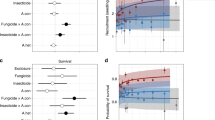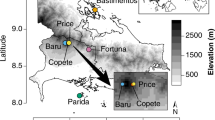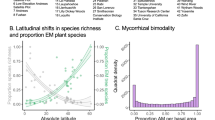Abstract
Tropical forests are important reservoirs of biodiversity1, but the processes that maintain this diversity remain poorly understood2. The Janzen–Connell hypothesis3,4 suggests that specialized natural enemies such as insect herbivores and fungal pathogens maintain high diversity by elevating mortality when plant species occur at high density (negative density dependence; NDD). NDD has been detected widely in tropical forests5,6,7,8,9, but the prediction that NDD caused by insects and pathogens has a community-wide role in maintaining tropical plant diversity remains untested. We show experimentally that changes in plant diversity and species composition are caused by fungal pathogens and insect herbivores. Effective plant species richness increased across the seed-to-seedling transition, corresponding to large changes in species composition5. Treating seeds and young seedlings with fungicides significantly reduced the diversity of the seedling assemblage, consistent with the Janzen–Connell hypothesis. Although suppressing insect herbivores using insecticides did not alter species diversity, it greatly increased seedling recruitment and caused a marked shift in seedling species composition. Overall, seedling recruitment was significantly reduced at high conspecific seed densities and this NDD was greatest for the species that were most abundant as seeds. Suppressing fungi reduced the negative effects of density on recruitment, confirming that the diversity-enhancing effect of fungi is mediated by NDD. Our study provides an overall test of the Janzen–Connell hypothesis and demonstrates the crucial role that insects and pathogens have both in structuring tropical plant communities and in maintaining their remarkable diversity.
This is a preview of subscription content, access via your institution
Access options
Subscribe to this journal
Receive 51 print issues and online access
$199.00 per year
only $3.90 per issue
Buy this article
- Purchase on Springer Link
- Instant access to full article PDF
Prices may be subject to local taxes which are calculated during checkout




Similar content being viewed by others
References
Gibson, L. et al. Primary forests are irreplaceable for sustaining tropical biodiversity. Nature 478, 378–381 (2011)
Wright, S. J. Plant diversity in tropical forests: a review of mechanisms of species coexistence. Oecologia 130, 1–14 (2001)
Janzen, D. H. Herbivores and the number of tree species in tropical forests. Am. Nat. 104, 501–528 (1970)
Connell, J. H. in Dynamics of Numbers in Populations (eds den Boer, P. J. & Gradwell, G. R. ) 298–312 (PUDOC, 1971)
Harms, K. E., Wright, S. J., Calderón, O., Hernández, A. & Herre, E. A. Pervasive density-dependent recruitment enhances seedling diversity in a tropical forest. Nature 404, 493–495 (2000)
Metz, M. R., Sousa, W. & Valencia, R. Widespread density-dependent seedling mortality promotes species coexistence in a highly diverse Amazonian rain forest. Ecology 91, 3675–3685 (2010)
Bagchi, R. et al. Testing the Janzen-Connell mechanism: pathogens cause overcompensating density dependence in a tropical tree. Ecol. Lett. 13, 1262–1269 (2010)
Comita, L. S. & Hubbell, S. P. Local neighborhood and species' shade tolerance influence survival in a diverse seedling bank. Ecology 90, 328–334 (2009)
Terborgh, J. Enemies maintain hyperdiverse tropical forests. Am. Nat. 179, 303–314 (2012)
Chesson, P. Mechanisms of maintenance of species diversity. Annu. Rev. Ecol. Syst. 31, 343–366 (2000)
Curran, L. M. et al. Lowland forest loss in protected areas of Indonesian Borneo. Science 303, 1000–1003 (2004)
Achard, F. et al. Determination of deforestation rates of the world’s humid tropical forests. Science 297, 999–1002 (2002)
Bonan, G. B. Forests and climate change: forcings, feedbacks, and the climate benefits of forests. Science 320, 1444–1449 (2008)
Bell, T., Freckleton, R. P. & Lewis, O. T. Plant pathogens drive density-dependent seedling mortality in a tropical tree. Ecol. Lett. 9, 569–574 (2006)
Mangan, S. A. et al. Negative plant-soil feedback predicts tree-species relative abundance in a tropical forest. Nature 466, 752–755 (2010)
Bever, J. D. Feedback between plants and their soil communities in an old field community. Ecology 75, 1965–1977 (1994)
Packer, A. & Clay, K. Soil pathogens and spatial patterns of seedling mortality in a temperate tree. Nature 404, 278–281 (2000)
Webb, C. O. & Peart, D. R. Seedling density dependence promotes coexistence of Bornean rain forest trees. Ecology 80, 2006–2017 (1999)
Theimer, T. C., Gehring, C. A., Green, P. T. & Connell, J. H. Terrestrial vertebrates alter seedling composition and richness but not diversity in an Australian tropical rain forest. Ecology 92, 1637–1647 (2011)
Leigh, E. G., Wright, S. J., Herre, E. A. & Putz, F. E. The decline of tree diversity on newly isolated tropical islands: a test of a null hypothesis and some implications. Evol. Ecol. 7, 76–102 (1993)
Terborgh, J. et al. Tree recruitment in an empty forest. Ecology 89, 1757–1768 (2008)
Hammond, D. S. & Brown, V. K. in Dynamics of Tropical Communities (eds G. R. Newbery, D. M., Prins, H. H. T. & Brown, N. D. ) 51–78 (Blackwell, 1998)
Horn, H. S. Measurement of “overlap” in comparative ecological studies. Am. Nat. 100, 419–424 (1966)
Comita, L. S., Muller-Landau, H. C., Aguilar, S. & Hubbell, S. P. Asymmetric density dependence shapes species abundances in a tropical tree community. Science 329, 330–332 (2010)
Kobe, R. K. & Vriesendorp, C. F. Conspecific density dependence in seedlings varies with species shade tolerance in a wet tropical forest. Ecol. Lett. 14, 503–510 (2011)
Bagchi, R. et al. Impacts of logging on density-dependent predation of dipterocarp seeds in a southeast Asian rainforest. Phil. Trans. R. Soc. B 366, 3246–3255 (2011)
Paine, C. E. T. & Beck, H. Seed predation by neotropical rain forest mammals increases diversity in seedling recruitment. Ecology 88, 3076–3087 (2007)
Norghauer, J. M., Malcolm, J., Zimmerman, B. & Felfili, J. An experimental test of density- and distant-dependent recruitment of mahogany (Swietenia macrophylla) in southeastern Amazonia. Oecologia 148, 437–446 (2006)
Bridgewater, S. G. M. et al. A preliminary checklist of the vascular plants of the Chiquibul Forest, Belize. Edinb. J. Bot. 63, 269–321 (2006)
Bridgewater, S. A Natural History of Belize (Univ. Texas Press, 2012)
Ford, K. A. et al. Neonicotinoid insecticides induce salicylate-associated plant defense responses. Proc. Natl Acad. Sci. USA 107, 17527–17532 (2010)
Jost, L. Entropy and diversity. Oikos 113, 363–375 (2006)
Oksanen, J. et al. vegan: community ecology package v.2.0-8 (R Foundation for Statistical Computing, 2013)
R Development Core Team. R: a language and environment for statistical computing v.3.0.1 (R Foundation for Statistical Computing, 2013)
Pinheiro, J. C. & Bates, D. M. Mixed-Effects Models in S and S-Plus (Springer, 2000)
Carroll, R. J., Ruppert, D., Stefanski, L. A. & Crainiceanu, C. M. Measurement Error in Nonlinear Models: A Modern Perspective 2nd edn (Chapman & Hall/CRC, 2006)
Rue, H., Martino, S. & Chopin, N. Approximate Bayesian inference for latent Gaussian models by using integrated nested Laplace approximations. J. R. Stat. Soc. Ser. B 71, 319–392 (2009)
Acknowledgements
Permission to undertake research in the Chiquibul Forest Reserve was granted by the Ministry of Natural Resources, Belize under Scientific Collection/Research Permit CD/60/3/07(20). We thank the staff at the Las Cuevas Research Station (the late N. Bol, C. Bol, M. Bol and J. Boucher) for their help; and R. Cocomb, E. Miles, C. Rasell, M. Senior, T. Swinfield and O. Theisinger provided field assistance. H. Rue provided advice on implementing measurement error models in INLA. This research was funded by the Natural Environment Research Council (NERC; standard grant NE/DO10721/1) and S.G. was funded by grant 126296 from the Academy of Finland.
Author information
Authors and Affiliations
Contributions
O.T.L., R.P.F. and S.J.G. conceived the project and obtained funding. R.B., R.E.G., S.G., O.T.L., L.N. and C.E.A. established fieldwork design and protocols, and carried out the fieldwork with advice from R.P.F. and S.J.G. Data analysis was carried out by R.B. with input from R.P.F. and O.T.L. R.B. wrote the first draft of the manuscript and all authors contributed to discussing the results and editing the manuscript.
Corresponding author
Ethics declarations
Competing interests
The authors declare no competing financial interests.
Extended data figures and tables
Extended Data Figure 2 A comparison of the observed seedling communities (observed survival) with those simulated either fixing survival to the mean for each species in each treatment (mean density survival) or allowing survival to be negatively density dependent (NDD survival).
The simulated values are means and 95% confidence intervals based on 1,000 simulations for effective number of species, total abundance and community dissimilarity to seeds falling in adjacent traps.
Supplementary information
Supplementary Table 1
This file shows the model coefficients (± standard deviation) for each species, which relate the numbers of seedlings to the number of seeds for each pesticide treatment. The parameters are described in equation 2 of the Methods. (PDF 202 kb)
Supplementary Data 1
This file includes the data, which is analysed in the main paper and associated with the R code supplied in Supplementary Notes 1. (XLS 580 kb)
Supplementary Notes 1
This document includes R code used to analyse the data supplied in Supplementary Data 1. (TXT 49 kb)
Rights and permissions
About this article
Cite this article
Bagchi, R., Gallery, R., Gripenberg, S. et al. Pathogens and insect herbivores drive rainforest plant diversity and composition. Nature 506, 85–88 (2014). https://doi.org/10.1038/nature12911
Received:
Accepted:
Published:
Issue Date:
DOI: https://doi.org/10.1038/nature12911
This article is cited by
-
Simple remedy for pitfalls in detecting negative density dependence
Plant Ecology (2024)
-
Latitudinal patterns in stabilizing density dependence of forest communities
Nature (2024)
-
Modelling how negative plant–soil feedbacks across life stages affect the spatial patterning of trees
Scientific Reports (2023)
-
Plant–soil feedback effects on conspecific and heterospecific successors of annual and perennial Central European grassland plants are correlated
Nature Plants (2023)
-
Effects of moisture and density-dependent interactions on tropical tree diversity
Nature (2023)
Comments
By submitting a comment you agree to abide by our Terms and Community Guidelines. If you find something abusive or that does not comply with our terms or guidelines please flag it as inappropriate.



